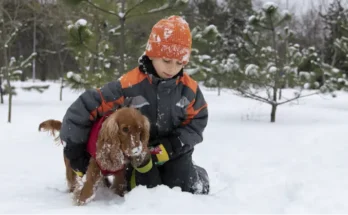Do you want a well-trained new dog? Are you curious about dog training?
An essential aspect of ethical pet ownership is training your dog, whether it is a rescue, shelter, or new puppy.
Dogs that receive obedience training perform well in public and pay attention to strangers. You protect your family’s comfort and your dog’s safety when you train them.
You may teach your dog to obey basic one-word orders like “sit” and intricate multi-step routines like catching a Frisbee.
How to train your dog?
Basics of Dog Training
- Launch a Program for Dog Obedience: Before training your dog, learn how to lay the groundwork. It will be simpler for everyone if both you and the dog follow consistent practices, which will assist in development.
- Employ Positive Reinforcement: When training a dog, you should give rewards for desired actions and disregard those that you find objectionable. Treats, toys, pets, or anything else the dog responds to can be used as a reward. Potty-prepared dogs could be prepared to ring these brilliant doggie doorbells to make you when they need aware of assuage themselves on account of these “fulfilling” strategies.
- Make Training Fun: If learning isn’t enjoyable for you or your dog, why would either of you want to learn? To avoid getting frustrated, make your tone light and treat your dog fairly during training sessions. Your training lessons will be far more productive if you’re both having fun.
Show Off Your Order
It’s important to be explicit with your dog when you first begin training them. Dogs cannot understand human language, thus you must explain the meaning of the instruction to them.
To get the dog to sit, for example, give it the command and then gently press its butt to the ground. When you issue the order, you may also have someone else try to mimic the activity. It facilitates the dog’s quicker learning of the action.
Present the Gift
Treats are a useful tool for rewarding your dog for good behavior. Select goodies that your dog adores but cannot have every day.
Show your dog a reward when you deliver the command. Even though it could be difficult, you must resist giving in to your pet’s puppy dog eyes to reward it with a treat before it obeys the command.
Become Enthusiastic
Exciting noises and moves provide a positive response from dogs, particularly in training. During your training sessions, try adding hand gestures and animated sounds like clicks and whistles.
You can also express your happiness to your dog once they have successfully understood and executed the instructions.
Recite the Directives
In addition to giving yourself positive reinforcement, you must repeatedly give orders. For your dog to learn your commands, they must be heard enough times.
It’s also essential to repeat the instructions to your pet so they understand that they will be rewarded at the end of it. You should give the command again to your dog even if it obeys it the first time around to make sure its behavior is consistent.
Important Lessons Your Dog Needs to Train Your Dog
It could take a dog a varying amount of time to pick up new commands. Nevertheless, the majority of dogs can follow these simple commands:
Sit :
One of the most fundamental commands you can give your dog is to sit. It will be simpler to maintain control over your dog if you can teach them to sit. Additionally, it becomes ready for more difficult commands like “Stay.” Once your dog sits, transfer the treat behind their head and hold it over their head. When they finish the command, give them the treat.
Come on:
You can use the command “come” to regain control of your dog if you mistakenly leave your front door open or lose your grasp on the leash. Your dog will stay secure and out of danger if you give them this command. Tie your dog’s leash gently around them and give them the instructions to come to you.
Remain:
The “Stay” signal makes it simple to control your dog, much like the “Sit” command. Ensure your canine is a specialist at the “Sit” sign before showing them this order. It will simplify mastery. When your dog is sitting, stand in front of him and give him an order to stay while holding out your hand.
Heel:
You can train the dog to heel if you exercise with them or if you live in a place where there isn’t enough space on the sidewalk. It facilitates your dog’s serene sidewalks.
Show thanks for the little things.
Never forget to give your dog praise for any progress, no matter how tiny.
Bring lifelong learning into work.
It’s far simpler to fit in numerous short training sessions if you incorporate training into your pet’s routine. For instance, before you feed your dog, walk them, or engage in playtime, ask them to sit or obey another order.
Attend a training session or speak with a dog trainer.
Don’t be afraid to enroll in a training session or get in touch with an expert dog trainer if you’re having trouble. Dog trainers have years of experience that they may utilize to help both of you and your dog, and they are typically one of the quickest ways to see results.
They should have thoughts on how to handle any troubles you may be having because they will have encountered a wide variety of challenges throughout their job.
In summary
Training with aversives should only be used as a component of a bigger strategy and comprehensive training program. Aversives are used to interrupt or reintroduce behaviors that a dog is already familiar with. Communication shouldn’t be limited to unpleasant words. You can only expect a little from a dog if the trainer’s only skill is beating it up.
Ultimately, we have no say over what a dog deems rewarding. What it finds satisfying, it finds satisfying. That’s okay if it’s just sniffing dandelions. Take a seat, relax, stay there, and sniff dandelions.
FAQs
Q. How long can you train the dog each day?
It is critical to have brief canine instructional courses so he will stay calm, relaxed, and energized. It tends to be only a couple of moments all at once.
Q. How do you teach a dog to stay away from other dogs?
There are various techniques to train your dog to stroll on walks without bothering other dogs, even if he should always be leashed.
Q. How can one teach their dog to stay in place?
A ton of specialists feel that pursuing an escaping dog will simply make him run quicker because he will see it as a game.
Q. How can one teach their dog to avoid jumping on people?
Begin by telling the dog to “sit,” then tell people to stay away.
Q. Which seven dog instructions are the most crucial ones?
Discover the seven common commands you use daily. Sit, stay, down, arrive, off, the heel, and no when you’re with your dog.



